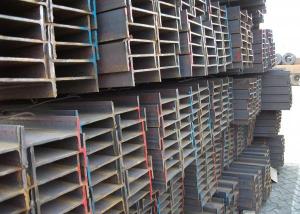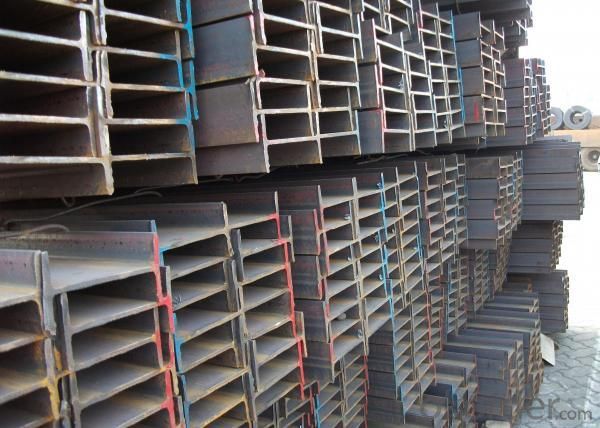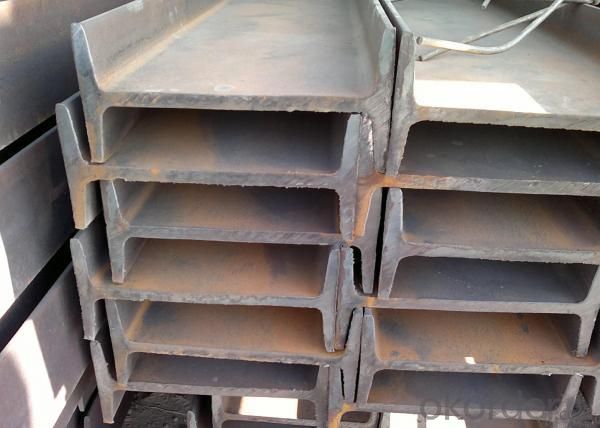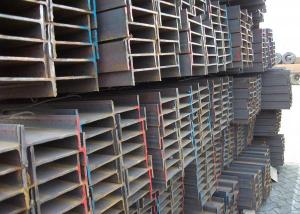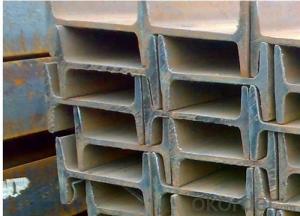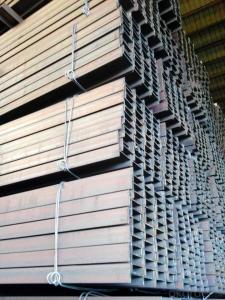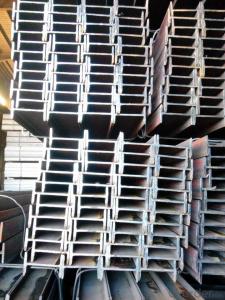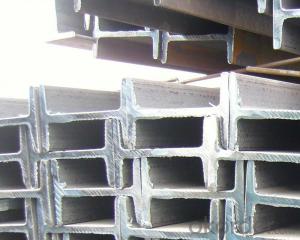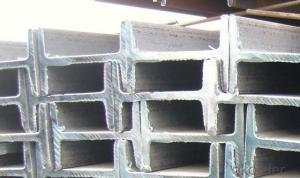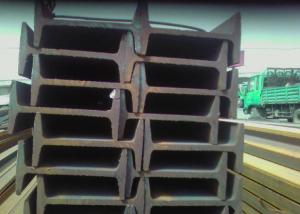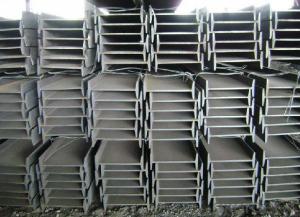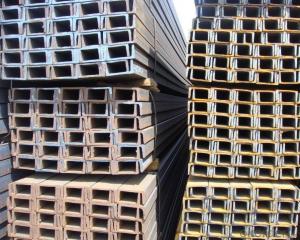Metal Structural Steel I-Beam
- Loading Port:
- Tianjin Port
- Payment Terms:
- TT or LC
- Min Order Qty:
- 15Mt m.t.
- Supply Capability:
- 10000Mt m.t./month
OKorder Service Pledge
OKorder Financial Service
You Might Also Like
Descriptions of Metal Structural Steel I-Beam
Grade:SS400,A36,S235JR,S275JR,Q235B. Size:80mm---270mm
1.Origin: Tangshan city . 2.Steel Material :Q195-Q235. ASTM A36, SS400.ect
3.Standard: GB ,JIS ,BS, ASTM, DIN. 4.Size: Meet standard size or as buyer's request .
5.Invoicing on theoretical weight or actual weight as customer request 6.Length: 5.8M, 6M, 8M, 9M, 12M.
Q235B
Chemical composition
|
Alloy No. |
Grade |
C |
Mn |
S |
P |
Si |
|
Q235 |
B |
1.12%-0.20% |
0.3%-0.7% |
<=0.045% |
<=0.045 |
<=0.3 |
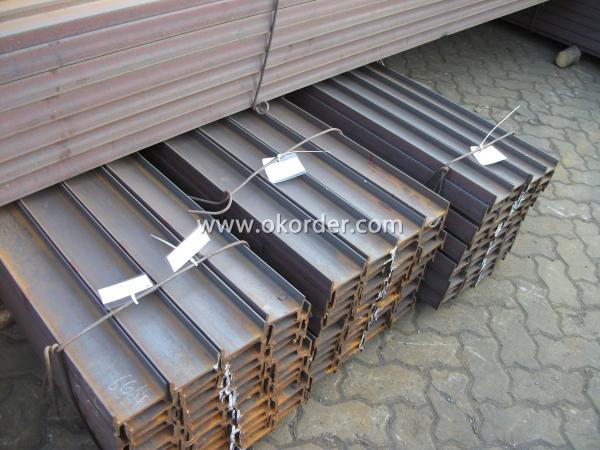
Applications of Metal Structral Steel I-Beam
1.Support structures 2.Pre-engineered buildings 3.Prefabricated structure
4.It is widely used in various building structures and engineering structures such as roof beams, bridges, transmission towers, hoisting machinery and transport machinery, ships, industrial furnaces, reaction tower, container frame and warehouse etc.
Packing & Devilivery of Metal Structual Steel I-Beam
1.Packing: All the metal structural steel I- Beams will be tied by wire rod in bundles and loaded in containers or in bulk cargo. All the bundles will be hung the markings of CNBM, which include the trademark, size, material, length, etc. We can also hang the lables according to the requriements of the customers.
2.Each bundle not more than 3.5MT for bulk vessel; less than 3 MT for container load
3.Tag mark: there will be tag mark tied up on the bundles. The information usually including supplier logo and name, product name, made in China, shipping marks and other information request by the customer. If loading by container the marking is not needed, but we will prepare it as customer request.
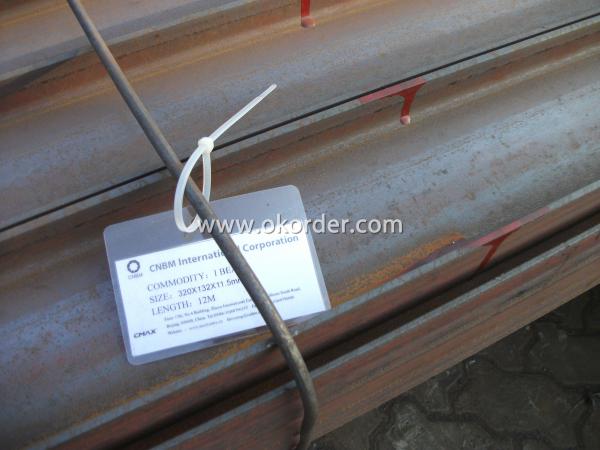
4.Delivery time: Within 30 days after receiving original L/C at sight or deposit by T/T, all the metal structural steel I-Beams will be transported to the port of loading and prepared to load.
5.Transportation: the goods are delivered by truck from mill to loading port, the maximum quantity can be loaded is around 40MTs by each truck. If the order quantity cannot reach the full truck loaded, the transportation cost per ton will be little higher than full load.
Payment terms of Metal Structural Steel I-Beam
1).100% irrevocable L/C at sight. 2).30% T/T prepaid and the balance against the copy of B/L.
3).30% T/T prepaid and the balance against L/C
Others terms of Metal Structural Steel I-Beam
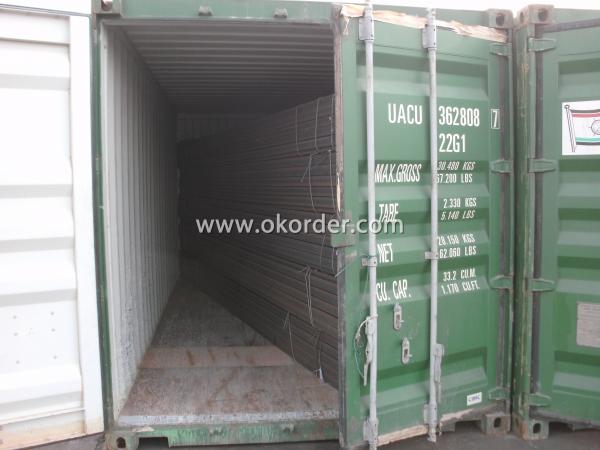
- Q: What is the purpose of a camber in a steel I-beam?
- The purpose of a camber in a steel I-beam is to counteract the natural deflection that occurs when the beam is loaded, ensuring that it remains straight and level under the anticipated load.
- Q: What are the different load configurations that Steel I-Beams can support?
- Steel I-Beams can support various load configurations, including but not limited to, uniform loads, point loads, distributed loads, and concentrated loads. These load configurations can be applied vertically or horizontally, depending on the specific structural design requirements.
- Q: How do steel I-beams perform in high humidity environments?
- The strength and durability of steel I-beams are widely recognized, and they exhibit excellent performance in high humidity conditions. Nevertheless, extended exposure to high humidity can potentially impact steel I-beams in various ways. One of the main concerns in high humidity settings is the potential for corrosion. When steel comes into contact with moisture, particularly in the presence of oxygen, it can undergo a chemical reaction and produce rust, which weakens its structural strength. The risk of corrosion may be elevated in areas with consistently high humidity. To counteract the effects of humidity on steel I-beams, several measures can be implemented. Firstly, the steel can be coated with protective coatings such as paint or galvanization. These coatings serve as a barrier against moisture and help prevent corrosion. Regular inspection and maintenance are also crucial for promptly identifying and addressing any signs of corrosion before they worsen. In addition, ensuring proper ventilation and humidity control within the environment can minimize the likelihood of moisture accumulation on the surface of steel I-beams. By maintaining relative humidity levels within recommended ranges, the risk of corrosion can be significantly reduced. In conclusion, while steel I-beams are generally dependable in high humidity environments, it is vital to employ protective measures and maintenance practices to ensure their long-term performance and structural integrity.
- Q: There are no columns in the middle of the workshop of 37 meters span. How much I-beam do I need?
- Ordinary I-beam, lightweight I-beam has formed the national standard, the common 10# I-beam is equivalent to the Internet I100 (such as 10# also channel equivalent channel (U100) for the implementation of the standards of different countries, which have subtle differences in their specifications)
- Q: Can steel I-beams be used for retail or commercial storefronts?
- Steel I-beams are suitable for retail or commercial storefronts. They are frequently used in commercial construction because of their strength and durability. These beams can handle heavy loads and ensure the building's structural integrity. Furthermore, steel I-beams offer the advantage of design flexibility, enabling spacious storefronts with minimal obstructions. Their ability to withstand strong winds and resist fire makes them a popular option for retail or commercial applications. Additionally, integrating steel I-beams with other materials like glass or masonry allows for visually pleasing storefront designs. In conclusion, steel I-beams are an excellent choice for retail or commercial storefronts as they provide both structural support and architectural appeal.
- Q: What does plain cold pressing hot steel mean?
- The hot metal from the torpedo car can be poured into the converter as the main burden after being treated by desulphurization and slag disposal, etc., with the addition of scrap steel below 10%. Then, burning into the converter oxygen blowing, excess carbon in molten iron by oxidation and release large amounts of heat, when the probe is measured to reach a predetermined low carbon content, namely stop blowing and tapping. In general, the ladle needs to be deoxidized and adjusted to operate the ingredients. Then, the carbonized rice hull is cast on the surface of the liquid steel to prevent the molten steel from being oxidized and sent to the continuous casting or die casting work area. For high requirement steel, increasing bottom blowing argon, RH vacuum treatment, spraying powder treatment (spraying SI - CA powder and denatured lime) can effectively reduce gas and inclusion in steel, and further reduce carbon and reduce sulfur. After these measures are refined, the ingredients can be adjusted to meet the demand of high quality steel.
- Q: How about 5 tons of crane rail fixed on I-steel
- First, the pressure plate shall be punched on i-beam. Second the guide rail is screwed with a hook screw and third is welded directly with the welding pressure plate
- Q: Can Steel I-Beams be used for industrial buildings?
- Yes, steel I-beams can be used for industrial buildings. Steel I-beams are commonly used in the construction of industrial buildings due to their strength, durability, and versatility. These beams provide excellent structural support, allowing for larger spans and higher load capacities, making them ideal for industrial applications. They can withstand heavy loads and provide stability and resistance to extreme weather conditions. Additionally, steel I-beams can be easily fabricated and customized to meet specific design requirements, making them a popular choice for industrial buildings where efficient and cost-effective construction is necessary.
- Q: Can steel I-beams be used in the construction of convention centers?
- Yes, steel I-beams can be used in the construction of convention centers. Steel I-beams are commonly used in construction due to their strength, durability, and versatility. They provide excellent support and load-bearing capabilities, making them ideal for large structures like convention centers. Steel I-beams can be used for framing, supports, and columns, helping to create a robust and stable structure. Additionally, steel is a sustainable and environmentally friendly material, making it a popular choice in modern construction projects.
- Q: Can steel I-beams be used in the construction of retail stores and shopping centers?
- Yes, steel I-beams can certainly be used in the construction of retail stores and shopping centers. Steel I-beams are highly versatile and commonly used in the construction industry due to their strength, durability, and cost-effectiveness. They are often used as structural support elements to create open floor plans, allowing for flexible layouts and large spans without the need for excessive columns or supports. Steel I-beams offer several advantages for retail store and shopping center construction. Firstly, their high strength-to-weight ratio allows for the creation of large, open spaces with minimal obstructions, providing ample room for product displays and customer flow. This not only enhances the shopping experience but also allows for easy reconfiguration of the space as needed. Additionally, steel I-beams are highly durable and resistant to pests, fire, and extreme weather conditions. This makes them suitable for use in retail environments where safety and longevity are crucial. Steel is also a sustainable material, as it can be recycled and reused, reducing its environmental impact. Furthermore, steel I-beams can be fabricated off-site, ensuring precision and efficiency during construction. This not only saves time but also reduces costs associated with labor and materials. Overall, steel I-beams are a preferred choice for the construction of retail stores and shopping centers due to their strength, versatility, durability, and cost-effectiveness. They provide the necessary structural support while allowing for flexible design options, making them an ideal choice for these types of commercial buildings.
1. Manufacturer Overview
| Location | Tangshan, China |
| Year Established | 2009 |
| Annual Output Value | Above US$ 230 Million |
| Main Markets | Mid East; Southeast Asia; Korea |
| Company Certifications | ISO 9001:2008; |
2. Manufacturer Certificates
| a) Certification Name | |
| Range | |
| Reference | |
| Validity Period |
3. Manufacturer Capability
| a) Trade Capacity | |
| Nearest Port | Tianjin; |
| Export Percentage | 81% - 90% |
| No.of Employees in Trade Department | 21-50 People |
| Language Spoken: | English; Chinese; |
| b) Factory Information | |
| Factory Size: | Above 500,000 square meters |
| No. of Production Lines | 1 |
| Contract Manufacturing | OEM Service Offered; |
| Product Price Range | Average |
Send your message to us
Metal Structural Steel I-Beam
- Loading Port:
- Tianjin Port
- Payment Terms:
- TT or LC
- Min Order Qty:
- 15Mt m.t.
- Supply Capability:
- 10000Mt m.t./month
OKorder Service Pledge
OKorder Financial Service
Similar products
Hot products
Hot Searches
Related keywords
